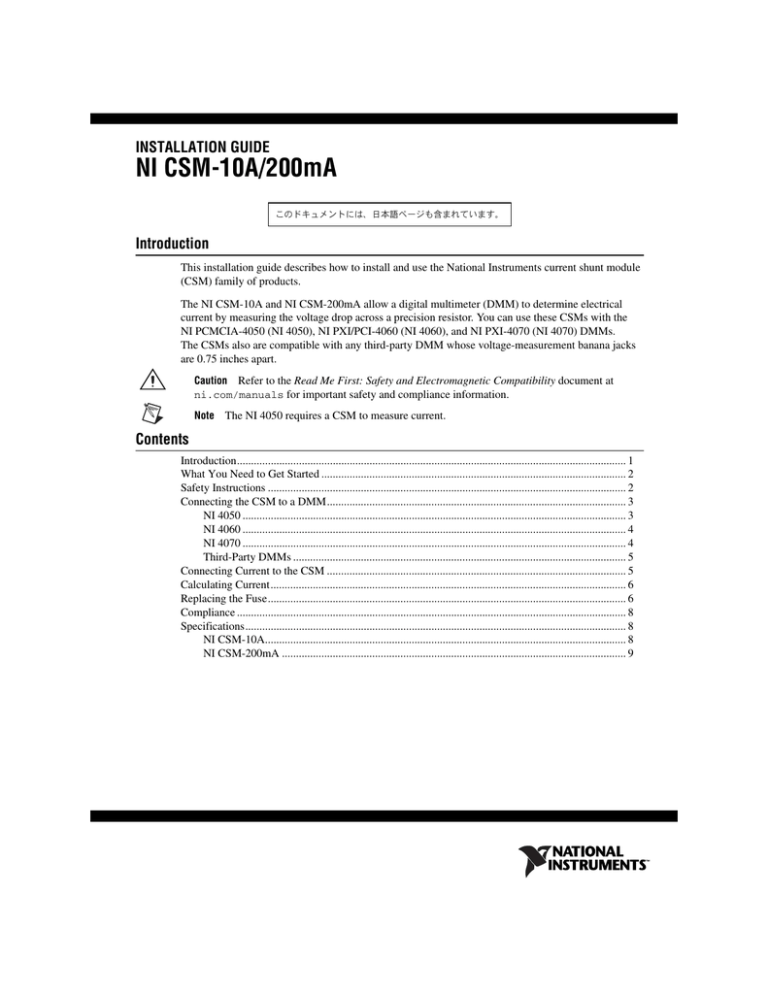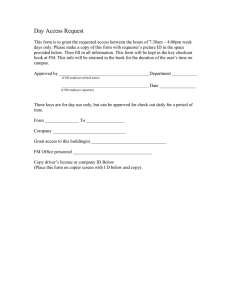
INSTALLATION GUIDE
NI CSM-10A/200mA
̭͈Ρ΅νιϋΠ͉ͅȂུࢊβȜΐ̳̞̀ͦ͘͘͜܄ȃ
Introduction
This installation guide describes how to install and use the National Instruments current shunt module
(CSM) family of products.
The NI CSM-10A and NI CSM-200mA allow a digital multimeter (DMM) to determine electrical
current by measuring the voltage drop across a precision resistor. You can use these CSMs with the
NI PCMCIA-4050 (NI 4050), NI PXI/PCI-4060 (NI 4060), and NI PXI-4070 (NI 4070) DMMs.
The CSMs also are compatible with any third-party DMM whose voltage-measurement banana jacks
are 0.75 inches apart.
Caution Refer to the Read Me First: Safety and Electromagnetic Compatibility document at
ni.com/manuals for important safety and compliance information.
Note
The NI 4050 requires a CSM to measure current.
Contents
Introduction.......................................................................................................................................... 1
What You Need to Get Started ............................................................................................................ 2
Safety Instructions ............................................................................................................................... 2
Connecting the CSM to a DMM.......................................................................................................... 3
NI 4050 ........................................................................................................................................ 3
NI 4060 ........................................................................................................................................ 4
NI 4070 ........................................................................................................................................ 4
Third-Party DMMs ...................................................................................................................... 5
Connecting Current to the CSM .......................................................................................................... 5
Calculating Current.............................................................................................................................. 6
Replacing the Fuse............................................................................................................................... 6
Compliance .......................................................................................................................................... 8
Specifications....................................................................................................................................... 8
NI CSM-10A................................................................................................................................ 8
NI CSM-200mA .......................................................................................................................... 9
What You Need to Get Started
To set up and use the CSM, you need the following:
❑ One of the following CSMs:
–
NI CSM-10A
–
NI CSM-200mA
❑ NI 4050 with cable, NI 4060, NI 4070, or a third-party DMM
❑ One pair of test probes (red and black)
❑ Flat-head screwdriver
Safety Instructions
This section contains important safety instructions that you must follow when installing and using the
NI CSM-10A or NI CSM-200mA.
Do not operate the CSM in a manner not specified in this installation guide. Misuse of the product can
result in a hazard. You can compromise the safety protection built into the product if the product is
damaged in any way. If the product is damaged, return it to NI for repair.
Do not substitute parts or modify the CSM. Use the product only with the modules, accessories, and
cables specified in the installation instructions.
Do not operate the CSM in an explosive atmosphere or where there may be flammable gases or fumes.
If you need to operate the CSM in such an environment, the CSM must be in a suitably rated enclosure.
If you need to clean the CSM, use a soft nonmetallic brush. The product must be completely dry and
free from contaminants before you return it to service.
Operate the CSM only at or below Pollution Degree 2. Pollution is foreign matter in a solid, liquid, or
gaseous state that can reduce dielectric strength or surface resistivity. The following is a description of
pollution degrees:
•
Pollution Degree 1 means no pollution or only dry, nonconductive pollution occurs. The pollution
has no influence.
•
Pollution Degree 2 means that only nonconductive pollution occurs in most cases. Occasionally,
however, a temporary conductivity caused by condensation must be expected.
•
Pollution Degree 3 means that conductive pollution occurs, or dry, nonconductive pollution occurs
which becomes conductive due to condensation.
You must insulate signal connections for the maximum voltage for which the CSM is rated. Do not
exceed the maximum ratings for the product. Do not install wiring while the product is live with
electrical signals. Do not remove or add connections when power is connected to the CSM.
Operate the CSM at or below the installation category1 marked on the hardware label. Measurement
circuits are subjected to working voltages2 and transient stresses (overvoltage) from the circuit to which
they are connected during measurement or test. Installation categories establish standard impulse
withstand voltage levels that commonly occur in electrical distribution systems. The following is a
description of installation categories:
1
2
Installation categories, also referred to as measurement categories, are defined in electrical safety standard IEC 61010-1.
Working voltage is the highest rms value of an AC or DC voltage that can occur across any particular insulation.
NI CSM-10A/200mA Installation Guide
2
ni.com
•
Installation Category I is for measurements performed on circuits not directly connected to the
electrical distribution system referred to as MAINS1 voltage. This category is for measurements of
voltages from specially protected secondary circuits. Such voltage measurements include signal
levels, special equipment, limited-energy parts of equipment, circuits powered by regulated
low-voltage sources, and electronics.
•
Installation Category II is for measurements performed on circuits directly connected to the
electrical distribution system. This category refers to local-level electrical distribution, such as that
provided by a standard wall outlet (for example, 115 V for U.S. or 230 V for Europe). Examples
of Installation Category II are measurements performed on household appliances, portable tools,
and similar products.
•
Installation Category III is for measurements performed in the building installation at the
distribution level. This category refers to measurements on hard-wired equipment such as
equipment in fixed installations, distribution boards, and circuit breakers. Other examples are
wiring, including cables, bus-bars, junction boxes, switches, socket-outlets in the fixed installation,
and stationary motors with permanent connections to fixed installations.
•
Installation Category IV is for measurements performed at the primary electrical supply
installation (<1,000 V). Examples include electricity meters and measurements on primary
overcurrent protection devices and on ripple control units.
Connecting the CSM to a DMM
This section illustrates how to connect a CSM to a DMM.
NI 4050
FUSE
250V/500mA Type F
CSM-200mA
200mA SHUNT 1Ω
184200B-01
HI
HI
MAX
250V/200mA
CAT II FUSED
250 V
MAX.
LO
LO
Figure 1. Connecting the CSM to the P4-BJ2 Cable Included with the NI 4050
1
MAINS is defined as a hazardous live electrical supply system that powers equipment. Suitably rated measuring circuits may
be connected to the MAINS for measuring purposes.
© National Instruments Corporation
3
NI CSM-10A/200mA Installation Guide
NI 4060
N AT IO N A L
INST RUME N TS
FUSE
250V/1.25A Type F
CSM-10A
10A SHUNT 0.01Ω
184199B-01
HI
HI
MAX
250V/10A
CAT II FUSED
V
Input 250V
Max
LO
LO
!
HI
250V
mA /
Max
4W 200mA
Max
Sense
LO
AUX I/O
5V
Max
Figure 2. Connecting the CSM to the NI 4060
NI 4070
FUSE
250V/12.5A Type F
CSM-10A
10A SHUNT 0.01Ω
184199B-01
N AT IO N A L
INST RUME N TS
NI PXI-4070
6½-Digit FlexDMM
HI
300 V
MAX
CAT II
HI
MAX
250V/10A
CAT II FUSED
INPUT
VΩ
LO
LO
1A
250 V
MAX
AMPS
HI
300 V
MAX
CAT II
SENSE
Ω 4W
LO
5V
MAX
AUX I/O
Figure 3. Connecting the CSM to the NI 4070
NI CSM-10A/200mA Installation Guide
4
ni.com
Third-Party DMMs
You can measure DC and ACrms current with the CSM and a third-party DMM, provided the DMM is
capable of measuring DC and ACrms voltage. Refer to the DMM documentation for voltage
measurement connection information.
Connecting Current to the CSM
The current to be measured connects to the HI (red) terminal of the CSM and returns through the LO
(black) terminal.
Cautions The current must never exceed the maximum input current specification for the
CSM you are using (10 A for the NI CSM-10A; 200 mA for the NI CSM-200mA).
To prevent possible safety hazards, the maximum voltage between either of the inputs and
ground of the measuring device should never exceed ±250 V or 250 Vrms.
FUSE
250V/500mA Type F
CSM-200mA
200mA SHUNT 1Ω
184200B-01
HI
MAX
250V/200mA
CAT II FUSED
LO
Figure 4. Connecting Current to the CSM
© National Instruments Corporation
5
NI CSM-10A/200mA Installation Guide
Calculating Current
The CSM operates by passing the input current through a precision resistor. Figure 5 shows the internal
circuitry of the CSM. You can find the resistance of the precision resistor in the Specifications section
of this document.
3
+
1
4
2
–
1
2
Voltage Across Resistor (VOUT)
Precision Resistor
3
4
Fuse
Current Source (IIN)
Figure 5. CSM Internal Construction
Measure the voltage drop across the resistor of the CSM. Use this value to calculate the current using
Ohm’s Law:
V OUT
I IN = ----------R
where
I is the input current
V is the voltage across the precision resistor
R is the resistance of the precision resistor
For example, assume you are using the CSM-200mA, which has a 1 Ω precision resistor, and the
measured voltage is 50 mV. Apply these values to Ohm’s Law to determine the current, as follows:
50 mV
50 mA = ---------------1Ω
Replacing the Fuse
Caution
For continued protection against fire, replace the fuse only with a fuse of the same type and
rating.
Figure 6 shows the location of the fuse on the front panel of the CSM. The fuse protects the current shunt
resistor if inputs exceed the maximum specified current rating provided in the Specifications section of
this document.
NI CSM-10A/200mA Installation Guide
6
ni.com
2
1
1
Fuse Holder
2
3
NI CSM-10A/200mA
3
Connectors
Figure 6. CSM Fuse Holder Location (Front View)
The fuse is a 5 × 20 mm quick-acting fuse. Table 1 lists the appropriate fuses for each CSM.
Table 1. CSM Fuse Values
Module
Fuse Rating
Fuse Type
Manufacturer
NI CSM-10A
12.5 A/250 V
Quick-acting
Schurter
NI CSM-200mA
500 mA/250 V
Quick-acting
Schurter
Complete the following steps to replace the CSM fuse:
1.
Power down all equipment connected to the CSM.
2.
Remove all connections from the CSM.
3.
Turn the fuse holder counter-clockwise with a flathead screwdriver and pull the fuse holder out to
expose the fuse in the housing.
FUSE
250V/500mA Type F
CSM-200mA
200mA SHUNT 1Ω
184200B-01
2
HI
3
MAX
250V/200mA
CAT II FUSED
LO
1
NI CSM-10A/200mA
2
1
Fuse
3
Fuse Holder
Figure 7. Removing the Fuse
4.
Remove the old fuse.
5.
Install the new fuse.
6.
Push the fuse holder back into the housing and turn it clockwise until it tightens completely.
© National Instruments Corporation
7
NI CSM-10A/200mA Installation Guide
Compliance
These products are designed to meet the requirements of the following standards of safety for electrical
equipment for measurement, control and laboratory use:
•
IEC/EN 61010-1
•
UL 3111-1
Specifications
The following sections list the specifications of the NI CSM-10A and NI CSM-200mA.
Note
These specifications are typical at 25 ºC unless otherwise stated.
NI CSM-10A
Current shunt..........................................................10 A
Conversion factor ...................................................1 mV = 100 mA
Max working current
HI to LO.........................................................10 A
Sense resistor value................................................0.01 Ω
Accuracy (DC–25 kHz) .........................................± 0.5%
Sense resistor temperature coefficient ...................20 ppm/ºC
Burden voltage .......................................................400 mV
Fuse type ................................................................12.5 A/250 V
5 × 20 mm
quick-acting
Banana jack spacing...............................................0.75 in. (19 mm)
Maximum Working Voltage
Maximum working voltage refers to the signal voltage plus the common-mode voltage.
HI to earth ground..................................................250 V max,
Installation Category II
LO to earth ground.................................................250 V max,
Installation Category II
Environmental
Operating temperature ...........................................0 to 55 °C
Storage temperature ...............................................–55 to 150 °C
Humidity ................................................................5 to 90% RH, noncondensing
Maximum altitude..................................................2,000 m
Pollution Degree (indoor use only)........................2
NI CSM-10A/200mA Installation Guide
8
ni.com
NI CSM-200mA
Current shunt..........................................................200 mA
Conversion factor ...................................................100 mV = 100 mA
Max working current
HI to LO.........................................................200 mA
Sense resistor value................................................1 Ω
Accuracy (DC–25 kHz) .........................................± 0.075%
Sense resistor temperature coefficient ...................20 ppm/°C
Burden voltage .......................................................325 mV
Fuse type ................................................................500 mA/250 V
5 × 20 mm
quick-acting
Banana jack spacing...............................................0.75 in. (19 mm)
Maximum Working Voltage
Maximum working voltage refers to the signal voltage plus the common-mode voltage.
HI to earth ground..................................................250 V max,
Installation Category II
LO to earth ground.................................................250 V max,
Installation Category II
Environmental
Operating temperature ...........................................0 to 55 °C
Storage temperature ...............................................–55 to 150 °C
Humidity ................................................................5 to 90% RH, noncondensing
Maximum altitude..................................................2,000 m
Pollution Degree (indoor use only)........................2
© National Instruments Corporation
9
NI CSM-10A/200mA Installation Guide
LabVIEW, National Instruments, NI, ni.com, the National Instruments corporate logo, and the Eagle logo are trademarks of National Instruments
Corporation. Refer to the Trademark Information at ni.com/trademarks for other National Instruments trademarks. Other product and
company names mentioned herein are trademarks or trade names of their respective companies. For patents covering National Instruments
products/technology, refer to the appropriate location: Help»Patents in your software, the patents.txt file on your media, or the National
Instruments Patent Notice at ni.com/patents.
© 1997–2010 National Instruments Corporation. All rights reserved.
371467D
Sep10



